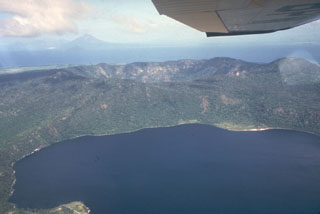Report on Apoyeque (Nicaragua) — 5 September-11 September 2012
Smithsonian Institution / US Geological Survey
Weekly Volcanic Activity Report, 5 September-11 September 2012
Managing Editor: Sally Sennert.
Please cite this report as:
Global Volcanism Program, 2012. Report on Apoyeque (Nicaragua) (Sennert, S, ed.). Weekly Volcanic Activity Report, 5 September-11 September 2012. Smithsonian Institution and US Geological Survey.
Apoyeque
Nicaragua
12.242°N, 86.342°W; summit elev. 518 m
All times are local (unless otherwise noted)
INETER reported that a seismic swarm near Apoyeque started at 1627 on 6 September in an area between the volcano and Managua (less than 10 km SW). At the time of the report, almost four hours after the start of the event, 17 earthquakes had been detected; three events were M 2.3-3.7, at depths ranging from 2.8 to 6 km. No earthquakes were recorded on 9 September.
Geological Summary. The Apoyeque volcanic complex occupies the broad Chiltepe Peninsula, which extends into south-central Lake Managua. The peninsula is part of the Chiltepe pyroclastic shield volcano, one of three large ignimbrite shields on the Nicaraguan volcanic front. A 2.8-km wide, 400-m-deep, lake-filled caldera whose floor lies near sea level truncates the low Apoyeque edifice, which rises only about 500 m above the lake shore. The caldera was the source of a thick deposit of dacitic pumice that covers the surrounding area. The 2.5 x 3 km lake-filled Xiloá (Jiloá) maar is located immediately SE of Apoyeque. The Talpetatl lava dome was constructed between Laguna Xiloá and Lake Managua. Pumiceous pyroclastic flows from Laguna Xiloá were erupted about 6,100 years ago and overlie deposits of comparable age from the Masaya Plinian eruption.
Source: Instituto Nicaragüense de Estudios Territoriales (INETER)

